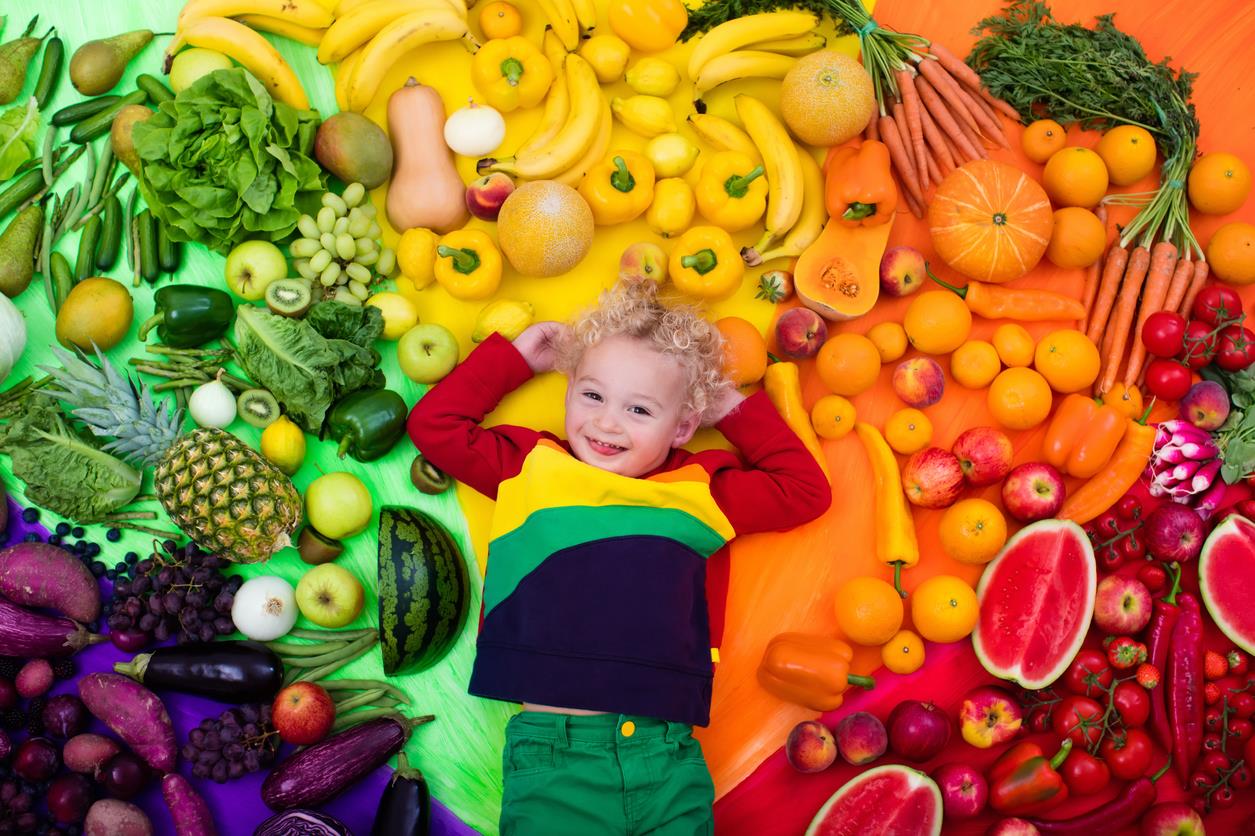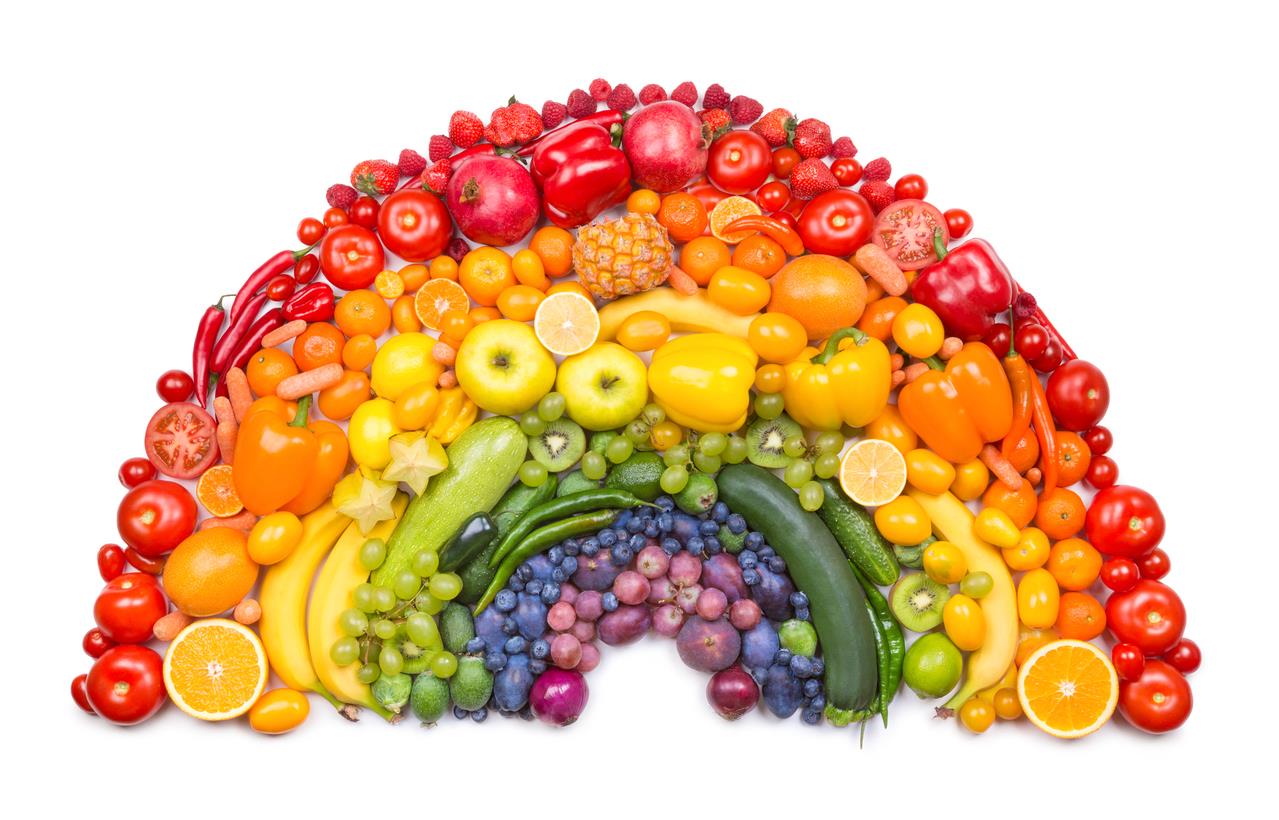Color Me Healthy! How to Eat a Rainbow

April showers bring… rainbows! May we suggest putting one on your menu for the week?
While it certainly sounds cool to dish up a slice of rain drops and dispersed light, what we actually mean is eating a rainbow of fresh, fabulous produce. Fruits and veggies get their vibrant hues from a wide variety of key nutrients, including vitamins, minerals, and antioxidants. Noshing on a broad spectrum of garden delights can help little growing (and big grown-up) bodies get everything they need.
Add veggies to mac and cheese, chili, soup, pizza, spaghetti sauce, burritos, eggs, casseroles, and smoothies (!), or slice ‘em up and serve with tasty dips.
Add fruit to sandwiches (it works great with cheese!), salads, pancakes, muffins, oatmeal, yogurt, and ice pops.
Each time you hit the grocery store or farmers’ market, ask your child to pick out a few fruits and veggies she loves in a range of colors—and then at least one new one to try. Or, surprise your family at your next meal by setting out a platter of raspberries, mandarins, pineapple, kiwi, blueberries, and purple grapes, all arranged in a rainbow-shaped arc. The kiddos won’t find gold at the end of this rainbow, but there’s plenty of nutrition inside!
The USDA recommends at least 2–5 cups of fruit and veggies per day for children, depending on their age. Fill your cups up with these colorful leads:

Red/Pink
The goods: Apples, beets, blood oranges, cherries, chili peppers, cranberries, guava, pink/red grapefruit, pomegranates, radicchio, radishes, raspberries, red grapes, red onions, red pears, red peppers, red potatoes, rhubarb, strawberries, tomatoes, and watermelon.
The good for you: Bursting with phytonutrients like lycopene, flavonoids, vitamin C, and folate, red foods promote heart and urinary tract health, support memory, and reduce inflammation.
Orange/Yellow
The goods: Apricots, bananas, butternut squash, cantaloupe, carrots, corn, lemons, mandarins, mangoes, nectarines, oranges, orange/yellow peppers, papaya, peaches, pears, persimmon, pineapple, pumpkin, sweet potatoes, tangerines, yams, yellow squash, and Yukon Gold potatoes.
The good for you: Packed with vitamin C, vitamin A, beta-carotene, and carotenoids, these cheery fruits and veggies support eye, skin, and heart health, and give your immune system a boost.
Green
The goods: Apples, artichokes, arugula, asparagus, avocado, bok choy, broccoli, Brussel sprouts, cabbage, celery, collards, cucumber, green beans, green grapes, green pears, green pepper, honeydew, kale, kiwi, leeks, lettuce, limes, okra, pears, peas, spinach, and zucchini.
The good for you: This verdant produce is full of chlorophyll, calcium, iron, omega-3 fatty acids, and the vitamins K, B, and E—which support eye health and keep bones and teeth strong.
Blue/Purple
The goods: Blackberries, blueberries, currants, eggplant, figs, plums, purple asparagus, purple carrots, purple grapes, purple potatoes, and red cabbage.
The good for you: Anthocyanins, antioxidants, vitamins C and K—oh my! The nutrients within these regal-hued foods protect DNA, promote bone and urinary tract health, improve memory, and increase circulation.
White
The goods: Asparagus, cauliflower, corn, fennel, garlic, ginger, Jerusalem artichokes, jicama, kohlrabi, mushrooms, onions, parsnips, potatoes, radishes, shallots, turnips, and white peaches.
The good for you: Brimming with flavonoids and vitamin B, white produce fortifies immunity, lowers cholesterol, and keeps the heart healthy.




